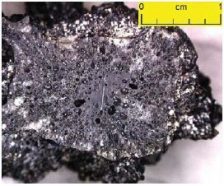Petrified lightning
Sand turned into glass by a lightning strike can provide clues about ancient climates.
By Emily Sohn
Lightning has amazing powers. One bolt heats the air to 30,000 degrees C. That’s five times as hot as the surface of the sun. Lightning can frighten pets and kids, start fires, destroy trees, and kill people.
Lightning also has the power to make glass.
 |
|
When lightning strikes the ground, it fuses sand in the soil into tubes of glass called fulgurites.
|
| L. Carion/Carion Minerals, Paris |
When a bolt of lightning strikes a sandy surface, the electricity can melt the sand. This melted substance combines with other materials. Then it hardens into lumps of glass called fulgurites. (Fulgur is the Latin word for lightning.)
Now, scientists are studying fulgurites in Egypt to piece together a history of the region’s climate.
Thunderstorms are rare in the desert of southwest Egypt. Between 1998 and 2005, satellites in space detected hardly any lightning in the area.
Amid the region’s sandy dunes, however, fulgurites are common. These lumps and tubes of glass suggest that lightning used to strike there more often in the past.
Recently, scientists from the National Autonomous University of Mexico in Mexico City studied fulgurites that had been collected in Egypt in 1999.
When heated, minerals in fulgurites glow. Over time, exposure to natural radiation causes small defects in the glassy fulgurites. The older the material is, the more defects there are, and the stronger the minerals glow at certain wavelengths of light when they’re heated. By measuring the intensity of the glow when the samples were heated, the researchers found that the fulgurites formed around 15,000 years ago.
 |
|
The gases trapped in bubbles within samples of fulgurite provide clues to ancient soil and atmospheric chemistry and climate.
|
| Rafael Navarro-González |
The scientists, for the first time, also looked at the gases trapped inside bubbles in the glass. Their chemical analyses showed that the landscape could have supported shrubs and grasses 15,000 years ago. Now, there’s only sand.
Today, shrubs and grasses grow in the hot, dry climate of Niger, 600 kilometers (375 miles) south of the Egypt site. The researchers suspect that, when the fulgurites were created, the climate in southwest Egypt was similar to present-day conditions in Niger.
Fulgurites and their gas bubbles are good windows into the past, scientists say, because such glasses remain stable over time.
Analyzing the Egyptian fulgurites, in particular, is “an interesting way of showing that the climate in this region has changed,” says Kenneth E. Pickering, an atmospheric scientist at NASA’s Goddard Space Flight Center in Greenbelt, Md.
Even if you’re afraid of thunderstorms, the amazing powers of lightning are bound to impress you! And lightning strikes can even tell a story of ancient times.—E. Sohn
Going Deeper:
Perkins, Sid. 2007. Stroke of good fortune: A wealth of data from petrified lightning. Science News 171(Feb. 17):101. Available at http://www.sciencenews.org/articles/20070217/fob5.asp .
You can learn more about fulgurites at en.wikipedia.org/wiki/Fulgurite (Wikipedia).







